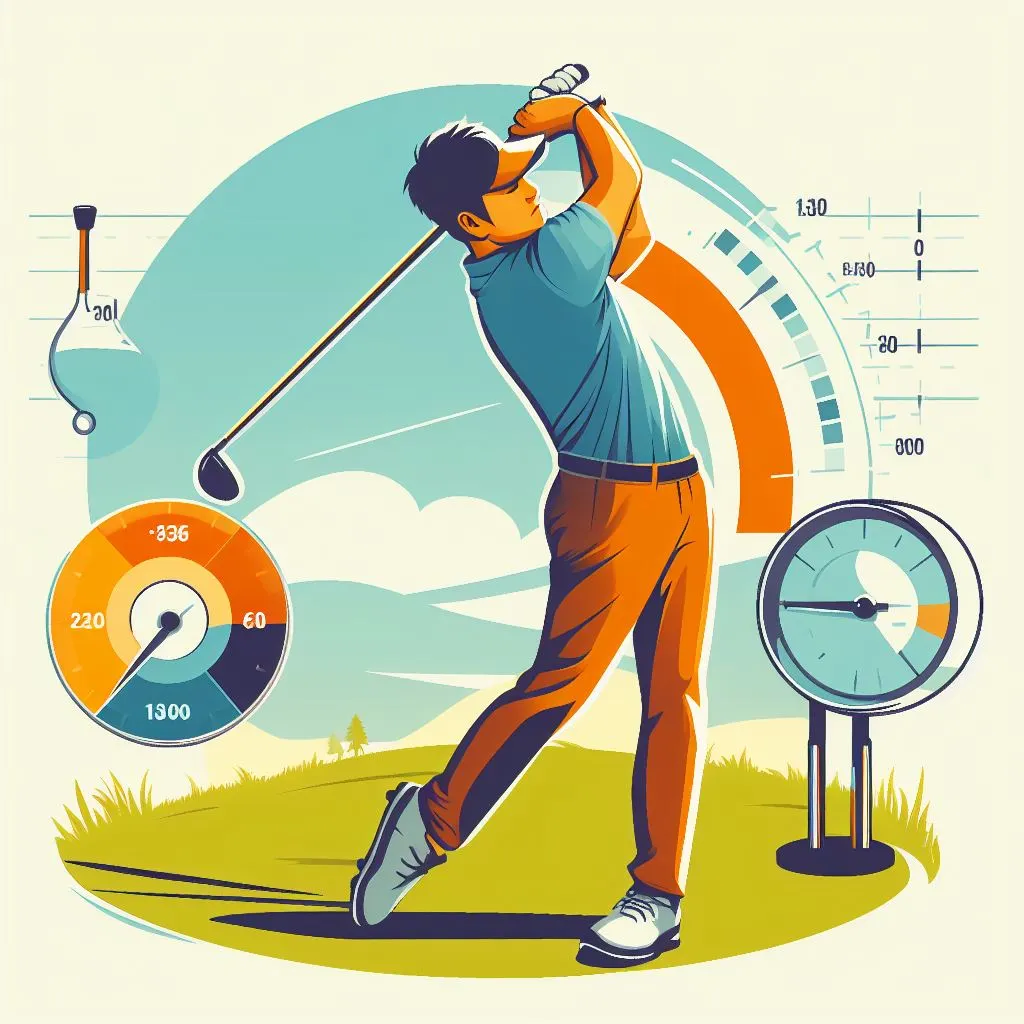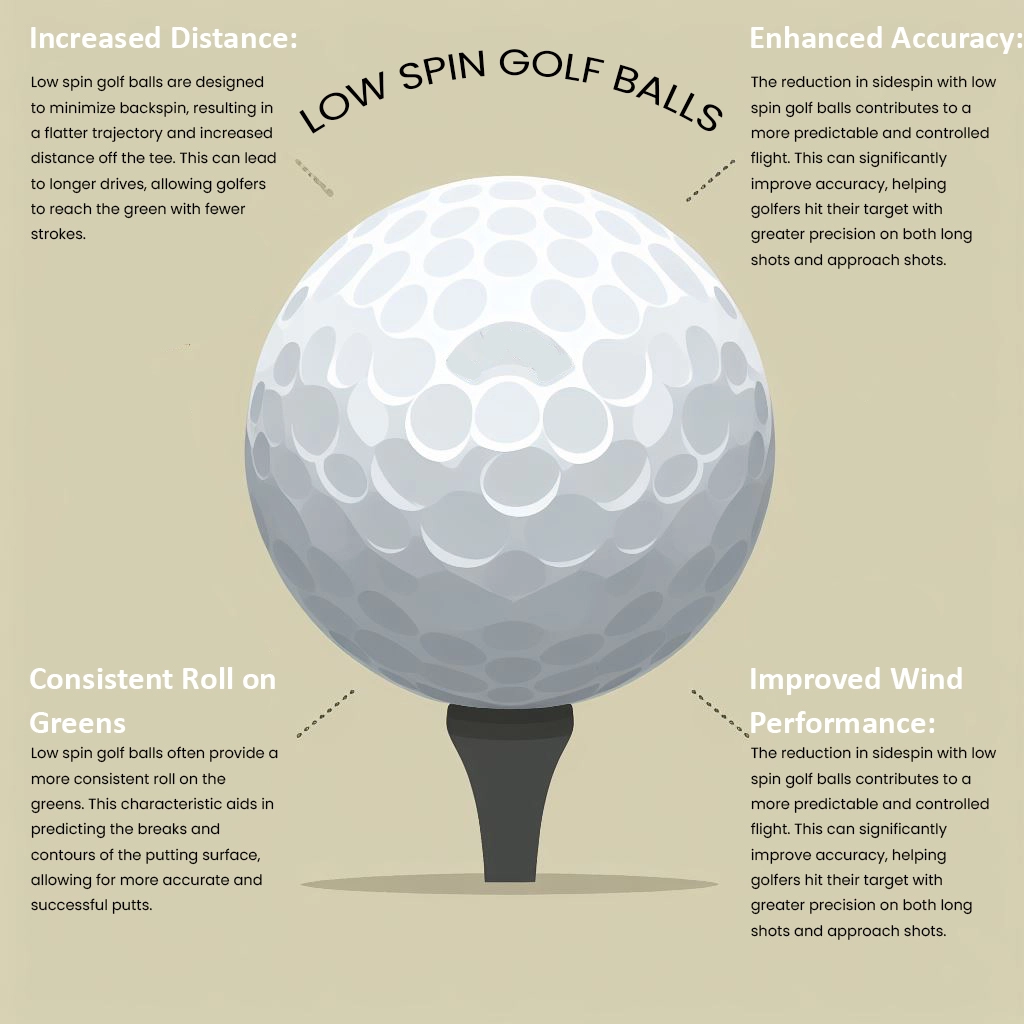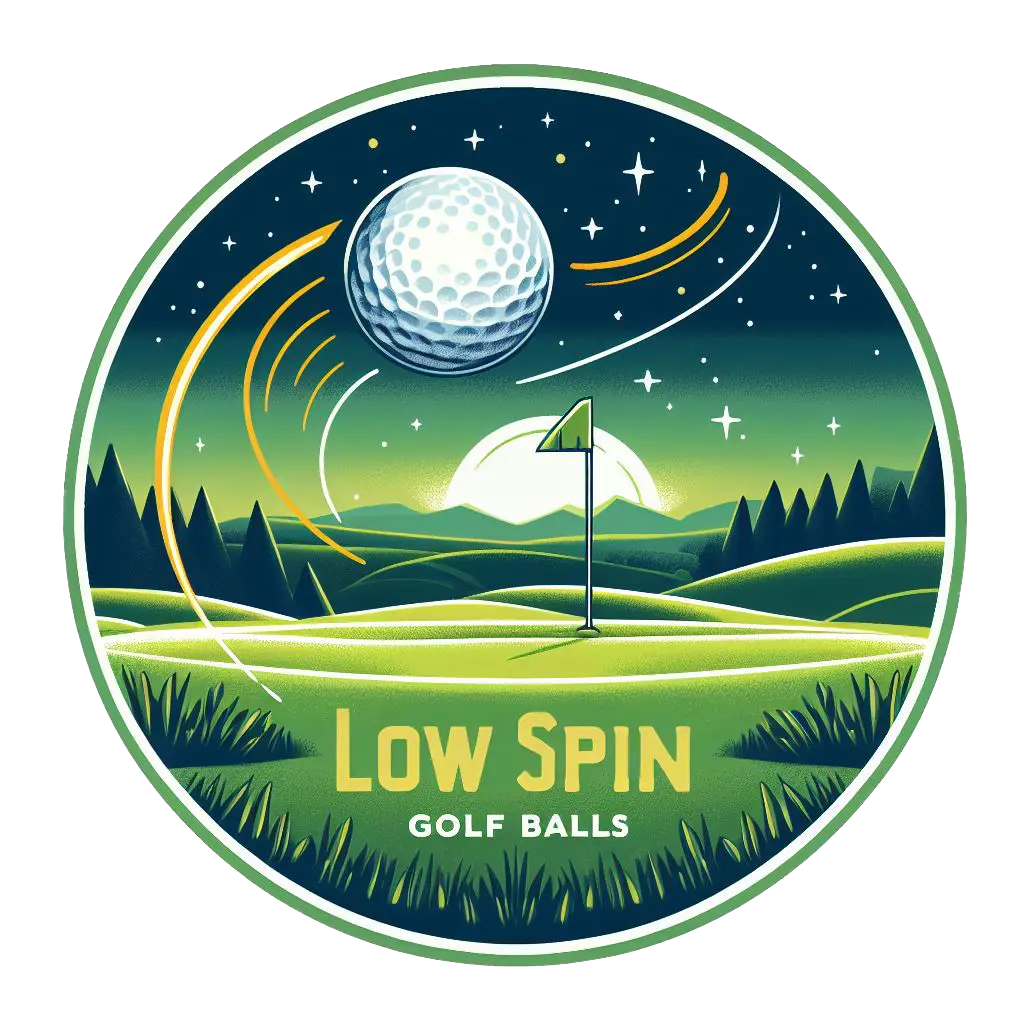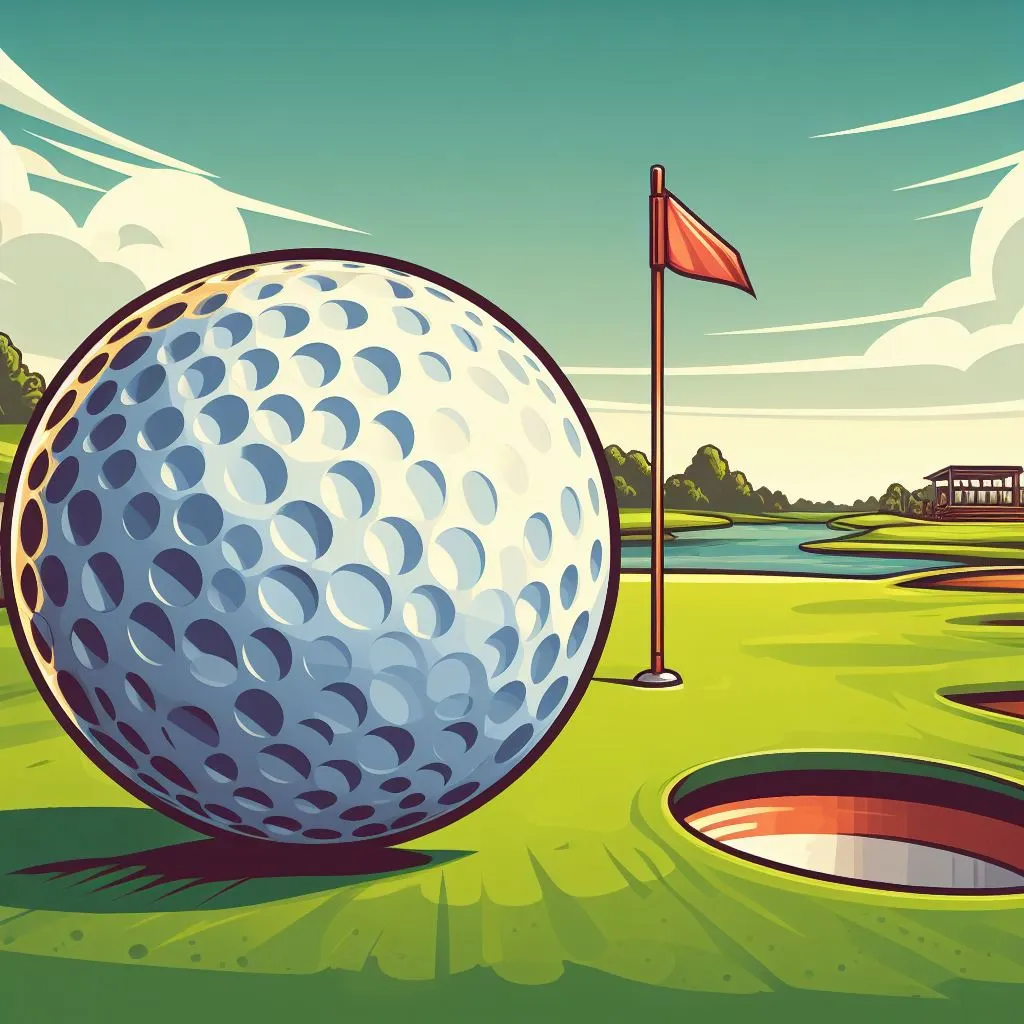Table of Contents
Introduction
In the world of golf, every swing, spin, and stroke can make a significant impact on your performance. One particular element that has garnered attention and sparked debate among golf enthusiasts is the role of spin, especially when it comes to the use of low-spin golf balls. In this in-depth exploration, we’ll delve into the science, benefits, drawbacks, and practical implications of incorporating low-spin golf balls into your game.
What Defines Low Spin Golf Balls and Their Impact on Performance?
Golf ball technology has evolved, introducing specialized categories such as low-spin golf balls. But what exactly defines these balls, and how do they influence your performance on the course?
Low-spin golf balls are designed to reduce the amount of backspin generated upon impact. Backspin, while essential for lift and distance, can sometimes result in a loss of control. These balls, engineered with advanced dimple patterns and core constructions, aim to minimize spin, offering golfers a unique set of advantages.
The Impact on Distance and Flight
The primary objective of low-spin golf balls is to enhance distance. By reducing backspin, these balls allow for a flatter trajectory, resulting in longer drives. It can be particularly beneficial for golfers seeking to gain extra yards off the tee without sacrificing control.
Control and Precision
Contrary to the common belief that lower spin equals less control, these golf balls can, in fact, improve precision. With less spin, shots become more stable, minimizing the chances of erratic hooks or slices. For golfers aiming to maintain accuracy, especially in windy conditions, low-spin balls can be a game-changer.

How Do Low Spin Golf Balls Differ from Traditional Golf Balls?
Understanding the distinctions between low-spin golf balls and their traditional counterparts is crucial for making an informed choice that aligns with your playing style.
Core Construction
Traditional golf balls typically feature a softer core, which generates more spin upon impact. In contrast, low spin golf balls often incorporate a firmer core aimed at minimizing spin and maximizing distance.
Dimple Design
Dimple design plays a significant role in controlling spin. Low-spin golf balls boast aerodynamically advanced dimple patterns that contribute to a more stable flight, reducing the chances of excessive spin.
Cover Material
The cover material of the golf ball also influences spin. Traditional balls may use softer materials, while low-spin options often incorporate harder covers to mitigate spin rates.
Are Low Spin Golf Balls Suitable for All Skill Levels?
One burning question many golfers have is whether low-spin golf balls are suitable for players of all skill levels.
Novice Golfers: Finding the Right Balance
For beginners, the focus is often on building a consistent swing and gaining control over the ball. Low-spin golf balls might not be the ideal choice initially, as mastering control becomes more crucial than maximizing distance.
Intermediate Players: Exploring Performance Gains
As golfers progress in skill, the benefits of low-spin golf balls become more apparent. Intermediate players can capitalize on the distance gains while refining their shot control.
Advanced Golfers: Precision and Fine-Tuning
Experienced golfers, especially those with high swing speeds, can leverage low-spin balls to fine-tune their shots. These players often prioritize precision and have the skill to capitalize on the advantages offered by low-spin technology.
The Science Behind Low Spin: Understanding the Dynamics
To truly appreciate the impact of low-spin golf balls, it’s essential to delve into the scientific principles that govern their performance.
Reducing Lift for a Flatter Trajectory
Low-spin golf balls work by minimizing the upward force generated during flight. This reduction in lift results in a flatter trajectory, allowing the ball to cut through the air with less resistance.
Minimizing Side Spin for Straighter Shots
Excessive side spin can lead to hooks or slices. Low spin balls aim to minimize side spin, promoting straighter shots and reducing the likelihood of veering off course.
Enhancing Aerodynamics for Maximum Distance
The aerodynamic design of low-spin golf balls is optimized to maximize distance. By reducing drag and optimizing lift, these balls can achieve greater distances, particularly off the tee.
Can Low Spin Golf Balls Improve Your Driving Distance?
For many golfers, the quest for greater driving distance is a perpetual pursuit. Let’s explore how low-spin golf balls play a role in this quest.
The Relationship Between Spin and Distance
Traditionally, golfers associated high spin with increased distance. However, advancements in golf ball technology have challenged this notion. Low-spin golf balls, with their emphasis on minimizing backspin, have emerged as contenders for maximizing driving distance.
Optimizing Launch Conditions
The key to unlocking additional yards off the tee lies in optimizing launch conditions. Low spin golf balls, with their flatter trajectory, can achieve a more efficient launch, translating into increased distance.
Impact of Swing Speed
It’s essential to consider individual swing speeds when evaluating the impact of low spin on driving distance. Golfers with moderate to high swing speeds are likely to experience the most significant distance gains with low-spin balls.
Exploring the Relationship Between Low Spin and Accuracy
Accuracy is a paramount concern for golfers at every skill level. How does the use of low-spin golf balls influence the delicate balance between distance and precision?
The Myth of Sacrificing Accuracy for Distance
One common misconception is that pursuing greater distance inherently compromises accuracy. Low-spin golf balls challenge this notion by offering a pathway to increased distance without sacrificing control.
Stability in Flight: A Precision Advantage
Reduced spin contributes to a more stable flight pattern. Golfers using low spin balls may find their shots less susceptible to the influence of crosswinds, resulting in improved accuracy, especially on long drives.
Fine-Tuning Your Game: The Accuracy-Boosting Potential
For golfers aiming to fine-tune their game and maintain a balance between distance and accuracy, low-spin golf balls provide a valuable tool in the arsenal.
Are There Drawbacks to Using Low Spin Golf Balls?
While the benefits of low-spin golf balls are evident, it’s essential to acknowledge potential drawbacks to make an informed decision.
Challenges in Generating Backspin Around the Greens
One notable drawback is the challenge of generating sufficient backspin for shots around the greens. Golfers who heavily rely on spin for precise control in their short game may need to adapt their approach when using low spin balls.
Response to Swing Variations
Low-spin golf balls are more responsive to variations in swing mechanics. While this responsiveness can be an advantage for skilled golfers, it may pose challenges for those still refining their swing consistency.
Balancing Act: Finding the Right Low Spin Ball
Not all low-spin golf balls are created equal. Finding the right ball that aligns with your playing style and preferences is crucial to mitigating potential drawbacks.
Do Low Spin Golf Balls Enhance Control Around the Greens?
The short game demands a delicate balance between spin and control. Can low-spin golf balls offer the finesse required for shots around the greens?
The Role of Spin in Approach Shots
Approach shots and pitches often rely on backspin for precision. Low-spin golf balls challenge golfers to adapt their approach, relying more on trajectory and landing angles for controlled shots.
Adaptation for Short Game Strategies
Golfers using low spin balls in their short game may need to adjust their strategies. Utilizing bump-and-run techniques and mastering the art of trajectory becomes crucial for success.
Precision Putting: Navigating the Greens
Putting is an area where the impact of spin is minimal. Low-spin golf balls can contribute to a smoother roll on the greens, enhancing precision in putting.
Choosing the Right Low Spin Golf Ball for Your Swing Style
With an array of low-spin golf balls available, the challenge lies in finding the perfect match for your unique swing style.
Understanding Your Swing Characteristics
Begin by understanding your swing characteristics, including swing speed and launch angle. These factors play a pivotal role in determining the most suitable low spin ball for your game.
Consulting with Golf Professionals
For personalized guidance, consider consulting with golf professionals. Their insights can help you identify the specific attributes in a low spin ball that complement your playing style.
Trial and Error: Finding Your Ideal Match
Choosing the right low-spin golf ball often involves a degree of trial and error. Experiment with different brands and models to discover the ball that optimally aligns with your swing style and preferences.
Comparing Low Spin Golf Balls: A Comprehensive Review
In the vast landscape of golf ball options, conducting a thorough comparison is essential for making an informed decision.
Leading Brands in Low Spin Technology
Several reputable brands specialize in low-spin golf ball technology. Explore offerings from Titleist, Callaway, TaylorMade, and Bridgestone to discover the unique features each brand brings to the table.
Performance Metrics: Distance, Control, and Feel
When comparing low-spin golf balls, consider essential performance metrics. Evaluate their impact on distance, shot control, and the overall feel of your shots to determine the best fit for your game.
User Reviews and Recommendations
User reviews provide valuable insights into real-world performance. Consider the experiences of fellow golfers and their recommendations when narrowing down your choices.
How Professional Golfers Benefit from Low Spin Ball Choices
Professional golfers meticulously choose their equipment to gain a competitive edge. How do low-spin golf balls contribute to the success of the pros?

Maximizing Distance in Competition Settings
In the competitive world of professional golf, distance often plays a pivotal role. Low-spin golf balls enable professionals to achieve optimal launch conditions, maximizing their driving distance.
Enhancing Shot Consistency
Professional golfers rely on shot consistency to maintain their competitive edge. Low spin balls contribute to a more predictable and repeatable shot pattern, which is crucial for success at the highest level.
Fine-Tuning Control for Precision Play
Precision is a hallmark of professional golf. Low spin balls allow pros to fine-tune their control, especially when navigating challenging courses and demanding shot scenarios.
The Role of Spin in Your Short Game: Low Spin vs. Traditional
The short game is an intricate dance between precision and finesse. How does the role of spin differ when comparing low spin to traditional golf balls?
Traditional Golf Balls: Embracing Spin for Precision
Traditional golf balls, with their emphasis on generating spin, have been the go-to choice for golfers relying on spin for precise control around the greens. This approach has been a staple in the short-game repertoire.
Low Spin Golf Balls: Navigating a New Approach
Low-spin golf balls challenge the conventional reliance on backspins in the short game. Golfers using low spin balls may adopt strategies that prioritize trajectory, landing angles, and bump-and-run techniques for successful approach shots.
The Hybrid Approach: Blending Spin Characteristics
Some golfers adopt a hybrid approach, selecting different ball types based on the specific requirements of their short-game shots. This strategic blending allows golfers to leverage the strengths of both low-spin and traditional balls.
Can Low Spin Golf Balls Help Reduce Slices and Hooks?
For golfers plagued by the frustrating tendencies of slices and hooks, the choice of a golf ball can play a pivotal role in mitigating these issues. Low-spin golf balls, with their emphasis on a flatter trajectory and reduced sidespin, offer a potential solution to the age-old problem of wayward shots.
One of the primary contributors to slices and hooks is the excessive sidespin imparted on the ball during the swing. Low-spin golf balls, designed to minimize sidespin, can help players achieve a more predictable and controlled flight. While it’s essential to acknowledge that swing mechanics and technique are paramount in addressing these shot shapes, the right choice of a golf ball can serve as a valuable complement in the quest for a straighter and more consistent game.
Breaking Down the Myths and Realities of Low Spin Golf Balls
As with any innovative golf technology, low-spin golf balls have been accompanied by a mix of myths and realities circulating within the golfing community. It’s crucial to dispel misconceptions to foster a better understanding of what these balls can truly offer.
Myth: Low Spin Balls Are Only for Professional Golfers
Contrary to popular belief, low-spin golf balls are not exclusive to professional players. While they do cater to the needs of advanced golfers, their benefits extend to a broader range of skill levels. Weekend warriors and mid-handicap players can also harness the advantages of these balls to improve their overall performance.
Reality: Low Spin Balls Require Adjustments in Playstyle
It’s essential to recognize that transitioning to low-spin golf balls may necessitate some adjustments in playstyle. Golfers accustomed to the feel of traditional balls may experience a period of adaptation. Patience and practice are key during this adjustment phase.
Myth: Low Spin Balls Sacrifice Greenside Control
A prevailing misconception is that opting for low-spin golf balls means sacrificing control around the greens. In reality, advancements in ball design have allowed manufacturers to strike a balance, providing golfers with both distance off the tee and the necessary control for approach shots and putting.
Reality: Choosing the Right Ball Depends on Personal Preferences
Selecting between low-spin and traditional golf balls ultimately boils down to personal preferences and playing style. Golfers who prioritize distance and control off the tee may find low spin balls more suitable, while those seeking enhanced stopping power on the greens may prefer traditional options.
Tips for Optimizing Your Swing with Low Spin Golf Balls
Making the most of low-spin golf balls involves aligning your swing mechanics with the characteristics of these specialized balls. Here are some tips to optimize your swing for better performance:
1. Focus on a Smooth Transition:
Achieving a smooth transition in your swing is crucial when using low-spin golf balls. Sudden changes in tempo or aggressive swings may disrupt the intended trajectory, affecting both distance and accuracy.
2. Fine-Tune Your Launch Angle:
Experiment with your launch angle to find the optimal trajectory for your swing. While low spin balls are designed for a flatter flight, slight adjustments to your launch angle can further enhance performance.
3. Work on Consistent Ball Striking:
Consistency in ball striking is key when using low-spin golf balls. Practicing a repeatable and controlled swing can help you unlock the full potential of these specialized balls.
4. Consider Professional Guidance:
Seeking advice from a golf professional can provide valuable insights into optimizing your swing for low-spin balls. A coach can analyze your swing mechanics and offer tailored recommendations for improvement.
Addressing Common Concerns: Dispelling Low Spin Golf Ball Misconceptions
While low-spin golf balls offer distinct advantages, some common concerns and misconceptions linger among golfers. Addressing these concerns head-on is essential for fostering a clear understanding of what these balls bring to the game.
Concern: Reduced Spin Equals Less Control
It’s a common worry that opting for low-spin golf balls translates to a loss of control, especially on approach shots. However, advancements in ball technology have allowed manufacturers to strike a balance, ensuring that low-spin balls offer both distance and greenside control.
Concern: Not Suitable for Average Golfers
Another prevalent misconception is that low-spin golf balls are exclusively designed for professional or low-handicap golfers. In reality, these balls can benefit a broad range of players, including mid-handicap and average golfers looking to optimize their performance.
Concern: Limited Feel and Feedback
Some golfers express concerns about the feel and feedback provided by low-spin golf balls. Manufacturers recognize the importance of maintaining a satisfactory feel, and modern low-spin balls are engineered to offer a balanced sensory experience without compromising performance.
Balancing Spin Rate: Finding the Sweet Spot for Your Game
Achieving the ideal balance in spin rate is a nuanced process that involves understanding your unique playing style and preferences. While low-spin golf balls inherently aim to reduce spin for specific advantages, finding the sweet spot for your game requires a thoughtful approach.
Consider Your Swing Speed:
Your swing speed plays a crucial role in determining the optimal spin rate for your game. Faster swing speeds may naturally generate more spin, influencing the type of golf ball that complements your playing style.
Experiment with Dimple Patterns:
Dimple patterns on golf balls contribute significantly to aerodynamics and spin characteristics. Experimenting with different dimple patterns can help you identify the one that aligns with your desired spin rates.
Evaluate Ball Construction:
Understanding the construction of low-spin golf balls is vital for balancing spin rates. Manufacturers often provide details on the core and cover materials, allowing you to choose a ball that caters to your preferences.
Factor in Course Conditions:
Course conditions, including weather and turf conditions, can impact spin rates. Adjusting your ball selection based on the specific conditions of the course you’re playing can contribute to a more tailored and effective approach.
Maximizing Performance: Low Spin Golf Balls and Putting Techniques
While much emphasis is placed on the impact of low-spin golf balls on long shots, their influence on putting techniques should be noticed. Maximizing performance on the greens involves understanding how these specialized balls interact with the putting surface.
Consistent Roll and Predictable Breaks:
Low-spin golf balls are designed to provide a more consistent roll on the greens. This characteristic can aid in predicting the breaks and contours of the putting surface, allowing golfers to make more accurate reads.
Adjusting Putting Speed:
The reduced spin of these golf balls may require a slight adjustment in putting speed. Experimenting with different speeds during practice can help you fine-tune your putting technique for optimal performance.
Feel and Feedback on the Greens:
Contrary to concerns about diminished feel, low-spin golf balls often offer a satisfactory feel on the greens. Evaluating the feedback provided by these balls can contribute to improved confidence and accuracy.
The Impact of Low Spin on Golf Ball Price: Worth the Investment?
As golfers explore the potential benefits of low-spin golf balls, a common consideration is the associated cost. Premium golf balls, especially those designed for specific performance characteristics, often come with a higher price tag. The question arises: Is the investment in low-spin golf balls justified, and what factors contribute to their pricing?
Construction and Materials:
The materials used in the construction of low-spin golf balls, including advanced core materials and cover formulations, contribute significantly to their performance characteristics. The use of high-quality materials often comes with an associated cost.
Research and Development:
The development of specialized golf balls involves extensive research and testing to fine-tune their performance attributes. Costs incurred in research and development contribute to the overall pricing of low-spin golf balls.
Brand Reputation:
Established brands with a reputation for producing high-performance golf balls may command higher prices. Golfers often consider brand reputation, along with performance, when making purchasing decisions.
Performance Benefits vs. Cost:
Ultimately, the decision to invest in low-spin golf balls comes down to weighing the performance benefits against the associated cost. For golfers seeking specific advantages in distance, accuracy, and overall control, the investment may be worthwhile.

Choosing the Right Low Spin Golf Ball Brand: A Buyer’s Guide
Navigating the array of low-spin golf ball options on the market requires careful consideration of brand offerings, performance characteristics, and individual preferences. Here’s a comprehensive buyer’s guide to aid you in selecting the right low-spin golf ball brand for your game.
Research Brand Reputation:
Begin your search by researching the reputation of different golf ball brands. Established brands with a history of producing quality balls are often a reliable choice.
Consider Performance Attributes:
Evaluate the specific performance attributes emphasized by each brand. Some may focus on distance, while others prioritize control. Choose a brand whose performance characteristics align with your playing style.
Read User Reviews:
User reviews provide valuable insights into real-world experiences with a particular brand and model. Reading reviews from fellow golfers can offer a practical perspective on what to expect from a specific low-spin golf ball.
Explore Product Lines:
Many brands offer a range of low-spin golf balls within their product lines. Explore the different options available, considering factors such as core construction, cover material, and dimple patterns.
Take Advantage of Trial Packs:
Some brands offer trial packs or sample sets, allowing you to test multiple ball models before committing to a larger purchase. Taking advantage of these trial options can help you find the ideal ball for your game.
Factor in Budget Considerations:
While performance is paramount, it’s essential to factor in your budget when choosing a low-spin golf ball brand. Determine the right balance between performance benefits and cost to make an informed decision.














Leave a Reply